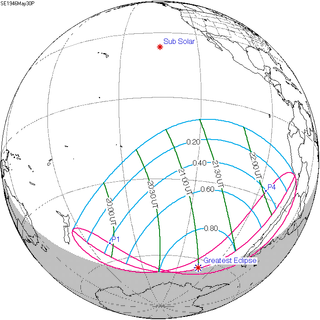A partial solar eclipse occurred on May 30, 1946. A solar eclipse occurs when the Moon passes between Earth and the Sun, thereby totally or partly obscuring the image of the Sun for a viewer on Earth. A partial solar eclipse occurs in the polar regions of the Earth when the center of the Moon's shadow misses the Earth.
| Solar eclipse of May 30, 1946 | |
|---|---|
| Type of eclipse | |
| Nature | Partial |
| Gamma | −1.0711 |
| Magnitude | 0.8865 |
| Maximum eclipse | |
| Coordinates | 64°06′S 101°00′W / 64.1°S 101°W |
| Times (UTC) | |
| Greatest eclipse | 21:00:24 |
| References | |
| Saros | 117 (65 of 71) |
| Catalog # (SE5000) | 9390 |
Related eclipses edit
Solar eclipses 1946–1949 edit
This eclipse is a member of a semester series. An eclipse in a semester series of solar eclipses repeats approximately every 177 days and 4 hours (a semester) at alternating nodes of the Moon's orbit.[1]
| Solar eclipse series sets from 1946 to 1949 | ||||||
|---|---|---|---|---|---|---|
| Ascending node | Descending node | |||||
| Saros | Map | Gamma | Saros | Map | Gamma | |
| 117 | 1946 May 30 Partial |
-1.07105 | 122 | 1946 November 23 Partial |
1.10500 | |
| 127 | 1947 May 20 Total |
-0.35279 | 132 | 1947 November 12 Annular |
0.37431 | |
| 137 | 1948 May 9 Annular |
0.41332 | 142 | 1948 November 1 Total |
-0.35172 | |
| 147 | 1949 April 28 Partial |
1.20682 | 152 | 1949 October 21 Partial |
-1.02696 | |
References edit
- ^ van Gent, R.H. "Solar- and Lunar-Eclipse Predictions from Antiquity to the Present". A Catalogue of Eclipse Cycles. Utrecht University. Retrieved 6 October 2018.
External links edit
- Earth visibility chart and eclipse statistics Eclipse Predictions by Fred Espenak, NASA/GSFC
